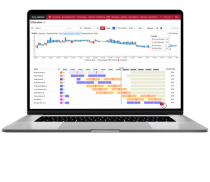- Products
- Solutions
Solutions
Services
- Resources
- Customers
Explore CSCCalabrio Success Center
Calabrio product training
- Partners
Workforce Engagement ManagementFind More Great Content- Customer Interaction Analytics
- Workforce Management
- Customer Experience
- Quality Management
- Contact Center Reporting
- Managing a Remote Workforce
Home » Workforce Optimization » Workforce Wellbeing: What Does It Really Mean and Why Does It Matter More Than Ever?
Workforce Wellbeing: What Does It Really Mean and Why Does It Matter More Than Ever?
Part One of Our Workforce Wellbeing Series Focuses on Reducing Stress in the Contact Center
Stress is a major barrier to success, and it is affecting everyone. Calabrio is campaigning to support improvements for people, processes, and technology to enable greater wellbeing across the contact center organizations. We feel that by prioritizing workforce wellbeing you can create an overall more efficient and successful contact center. This article outlines the key triggers for agents, supervisors and senior managers and shows why it pays to take a comprehensive approach to organizational wellbeing.
There’s no denying that the ever-changing digitalization of the contact center has been a tough transition for some contact centers with a growing number of remote working agents. Flexible working practices, growing customer demands and a fast-changing competitive landscape are all taking a toll on your frontline staff.
That’s why incorporating wellness initiatives is essential to help prevent agent attrition. While these stressors are affecting everyone in the contact center, thankfully, there are ways to help.
It Starts with Frontline Staff
In a recent survey about Agent Wellbeing and the Great Resignation, the study found that stress levels among frontline staff are rising sharply. In fact, 96% of agents claim to feel stress once a week, while 33% are stressed multiple times a week. Is it any wonder, considering they are dealing with 14.4 additional omnichannel interactions per day?
The increase in omnichannel expectations from your customers puts additional stress on your agents. As your contact center continues to adapt to customer expectations, your agents are required to increase their learning, juggle more interactions and assist the customer in a new and often challenging omnichannel approach.
At the same time, many people are still adapting psychologically to an often disorienting ‘work from anywhere’ culture facing the challenges of juggling home and work life. The reality is that this change hasn’t only impacted frontline staff.
Agent Stress Has a Direct Effect on Supervisors and Customer Experience (CX)
The Agent Wellbeing survey also uncovered that there is still a growing concern among respondents who feel that staff attrition and absence, while initially pandemic-related, continue to cause CX issues. Contact center leaders also need to under the bigger picture, such as why staff are leaving for the competition or why customer churn rates are higher than usual. The pressure is on contact center leaders to manage their agent’s mental wellbeing, oversee hybrid and remote agents’ work and increase the number the digital communication channels.
The stress of creating schedules and managing skills for your agents is the tip of the iceberg for managers and supervisors. There is also a need to optimize performance, keep teams connected and meet ever-increasing customer expectations. It’s all created a perfect storm of anxiety and stress that threatens the workplace wellbeing of employees and the long-term prosperity of an organization. So, what can be done to reverse this trend?
Three Ways to Improve Wellbeing
Workplace wellbeing needs to be an all-encompassing ideology in your contact center. When this happens, it translates into empowered agents, taking control of their working lives and improving customer experience. Supervisors also benefit from wellbeing initiatives because they can support the business with a motivated workforce that surpasses key metrics and service levels. At the very top, executives can incorporate workforce wellbeing into striking a balance between cost control, innovation and business expansion that’s not at the expense of the workforce.
Let’s explore some great examples of applying greater workforce wellbeing initiatives to your contact center.
Take an All-Around Approach
Find out what is working and what isn’t for your agents, supervisors and senior managers. This is truly a team effort. Look beyond the contact center and think about involving other parts of the organization, including subject matter experts, to improve knowledge, boost contact center performance and enhance employee wellbeing. What processes are in place to share best-practice CX learning so that all departments are encouraged to do better and increase their own sense of wellbeing?
Make the Most of Data
With customer and employee loyalty in flux during the pandemic, companies need deep, relevant insights inside and outside the organization to help protect and grow customer relationships while retaining skilled staff. All too often however, valuable information gets trapped inside the contact center. Essentially, many organizations are sitting on a goldmine of intelligence that isn’t used effectively – are you being held back by data silos or clunky IT systems?
Follow the Leaders
Success depends on gaining control over data using data-driven technologies. For example, Thomson Reuters wanted to understand how the introduction of remote agent onboarding and training was affecting its business. Read their customer success story below:
“Using the latest analytics, the company identified calls with long and multiple hold times, then worked to establish the reasons why this was happening. The goal was to eliminate putting calls on hold. As a result of the analytics program the company enjoyed significant benefits with a wide-ranging impact on organizational wellbeing.
For example, the Tax & Accounting Professionals Business Unit potentially saved up to 3% of its contact center’s annual operating budget. Meanwhile, average call times reduced by more than 90 seconds, call holds per call dropped one-and-a-half times and there was a 6.4% increase in customer satisfaction.”
As you can see, they used their analytics to reduce average calls and hold times to better meet their consumer needs.
Prioritize Your Contact Center’s Workforce Wellbeing
Employee wellbeing depends on reducing stress at all levels of the organization. In our next article, discover how modern workforce optimization solutions including AI-infused analytics are the answer to wellbeing. We will also look at how technology can be integral to enhancing staff engagement, optimizing contact center performance and boosting profitability.
Download the Workforce Wellbeing Recovery Kit to gain hints and tips for three key stakeholders, with the main stressors to target, checklists to process change and tech buyer’s guides.
Recent PostsCalabrio is a trusted ally to leading brands. The digital foundation of a customer-centric contact center, the Calabrio ONE workforce performance suite helps enrich and understand human interactions, empowering your contact center as a brand guardian.
We maximize agent performance, exceed customer expectations, and boost workforce efficiency using connected data, AI-fueled analytics, automated workforce management and personalized coaching.
Only Calabrio ONE unites workforce optimization (WFO), agent engagement and business intelligence solutions into a true-cloud, fully integrated suite that adapts to your business.
For customers and partners.
© Copyright 2024 Calabrio, Inc.Make Sure Your Contact Center Agents Know You Love Them3 Ways to De-Stress Employees with Technologies That Humanize the Hybrid WorkplaceSend this to a friend - Solutions














